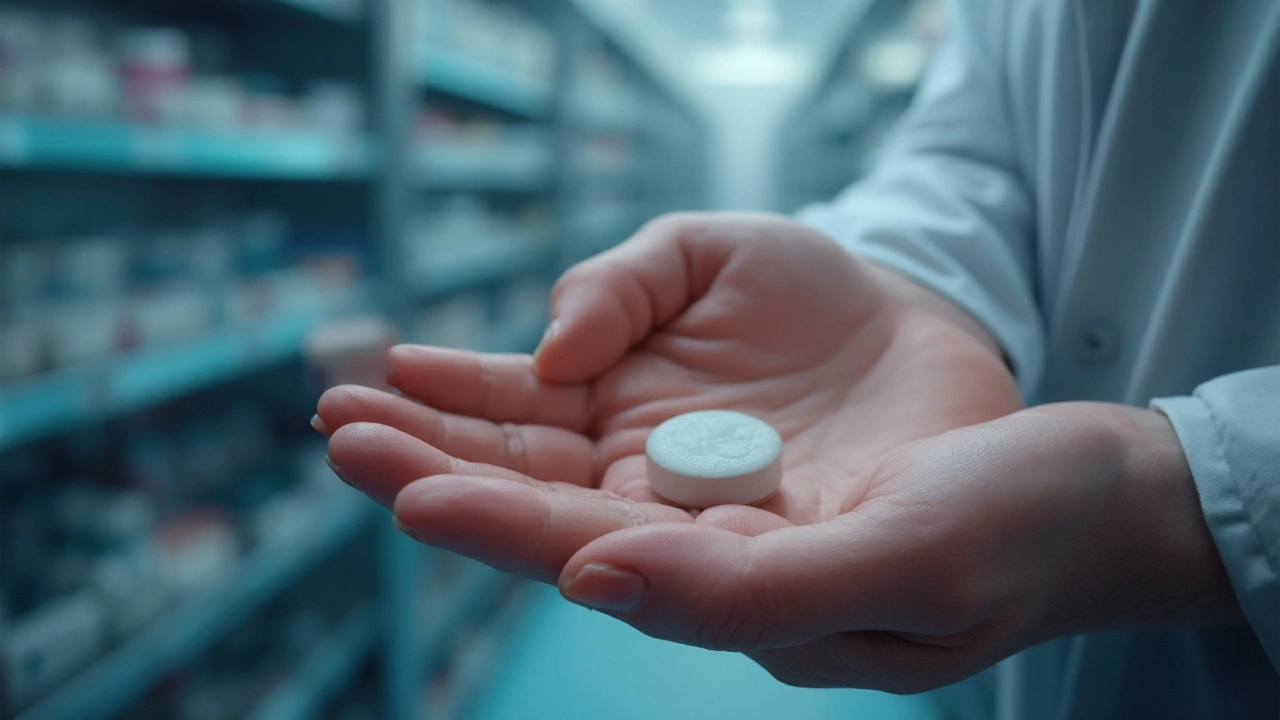TL;DR
- Prograf (tacrolimus) is an immunosuppressant used mainly after organ transplants.
- It works by inhibiting T‑cell activation, reducing the risk of organ rejection.
- Typical starting dose is 0.1mg/kg twice daily, adjusted to blood levels (5‑15ng/mL for most patients).
- Common side effects include tremors, kidney changes, high blood sugar, and headache.
- Monitor blood tests regularly and report any severe symptoms to your transplant team.
Understanding Prograf and Its Role in Transplant Care
When a patient receives a new organ-kidney, liver, heart, or lung-their immune system sees it as a foreign invader. The body’s natural response is to attack, which can destroy the graft within days or weeks. That’s where Prograf comes in. Its active ingredient, tacrolimus, is a potent calcineurin inhibitor that blocks a critical step in T‑cell activation. By damping down this pathway, it reduces the likelihood that the immune system will launch a full‑blown rejection.
Prograf was first approved by the FDA in 1994 and quickly became a cornerstone of modern transplant protocols because it offers a more targeted approach than older drugs like cyclosporine. Studies from the American Transplant Society (2022) show a 20% lower acute rejection rate when tacrolimus is part of a triple‑drug regimen (tacrolimus + mycophenolate + steroids) compared with cyclosporine‑based regimens.
Aside from organ transplantation, Prograf is occasionally prescribed for severe atopic dermatitis and certain autoimmune conditions, but those are off‑label uses and require specialist supervision.
Dosage Guidelines and Administration Tips
Getting the dose right is a balancing act. Too little and the graft is at risk; too much and the patient faces toxicity-especially kidney damage. Below is a practical framework that most transplant centres follow.
- Initial dosing: Most adults start at 0.1mg per kilogram of body weight, taken twice daily (every 12hours). For a 70kg adult that’s 7mg per dose, or 14mg total per day.
- Therapeutic drug monitoring (TDM): Blood trough levels are drawn just before the morning dose. Target ranges differ by organ:
- Kidney: 5‑15ng/mL
- Liver: 5‑10ng/mL
- Heart/Lung: 10‑20ng/mL
- Formulation: Prograf comes in capsules (0.5mg, 1mg, 3mg, 5mg) and a once‑daily extended‑release version called Advagraf. Most clinicians stick with the twice‑daily version for the first 3‑6months because it offers tighter control.
- Never crush or split the capsules-tacrolimus absorption is highly variable when the coating is broken.
- If you miss a dose, take it as soon as you remember unless it’s less than 6hours before the next scheduled dose. In that case, skip the missed one to avoid double‑dosing.
- Food interactions: A high‑fat meal can increase tacrolimus absorption by up to 30%. For consistency, take Prograf with the same type of meal (or with water only) every day.
- Drug interactions: Many medicines raise or lower tacrolimus levels.
- Increase levels: macrolide antibiotics (erythromycin, clarithromycin), azole antifungals (ketoconazole, fluconazole), grapefruit juice.
- Decrease levels: antiepileptics (phenytoin, carbamazepine), rifampin, St.John’s wort.
Below is a quick reference table for typical dosing scenarios:
| Patient Profile | Starting Dose (mg/day) | Target Trough (ng/mL) | Adjustment Frequency |
|---|---|---|---|
| Adult kidney transplant (70kg) | 14mg (7mg BID) | 5‑15 | Every 3‑5days |
| Adult liver transplant (80kg) | 16mg (8mg BID) | 5‑10 | Every 3‑5days |
| Pediatric kidney (30kg) | 6mg (3mg BID) | 8‑12 | Weekly until stable |
| Elderly (>75y) with reduced kidney function | 10mg (5mg BID) | 4‑8 | Every 5‑7days |
Always verify the exact dose with your transplant team; the numbers above are illustrative.

Managing Side Effects and When to Seek Help
Prograf is a life‑saving drug, but it’s not without a downside. Knowing the most common adverse events helps you catch problems early.
| Side Effect | Incidence | Typical Onset | Management Tips |
|---|---|---|---|
| Tremor | 30‑50% | Weeks‑months | Beta‑blockers (e.g., propranolol) under doctor guidance. |
| Nephrotoxicity | 15‑25% | Months‑years | Regular serum creatinine checks; dose reduction if eGFR <60mL/min. |
| Hyperglycemia | 10‑20% | First 3months | Dietary modifications; insulin or oral hypoglycemics if needed. |
| Hypertension | 20‑30% | Weeks‑months | ACE inhibitors or ARBs; monitor BP daily. |
| Headache | 10‑15% | Immediate‑days | OTC analgesics (acetaminophen) unless contraindicated. |
| Infection risk | Variable | Ongoing | Vaccinations pre‑transplant; prompt antibiotic therapy for suspicious fevers. |
While most of these issues are manageable, certain red‑flag symptoms demand immediate medical attention:
- Severe abdominal pain or vomiting - could signal pancreatitis.
- Sudden drop in urine output - possible acute kidney injury.
- Persistent fever >38°C for more than 48hours - risk of opportunistic infection.
- Unexplained bruising or bleeding - watch for thrombocytopenia.
Never stop Prograf abruptly; doing so can trigger acute rejection. If you experience a side effect that feels unbearable, talk to your transplant physician about switching to an alternative immunosuppressant (e.g., sirolimus) rather than stopping the drug yourself.
In addition to physical symptoms, mental health can be impacted. Some patients report mood swings, anxiety, or insomnia. A psychologist familiar with transplant patients can provide coping strategies, and certain medications (like low‑dose trazodone) may be safe when coordinated with your transplant pharmacist.
Mini‑FAQ
- Can I drink alcohol while on Prograf? Moderate intake (up to one drink daily) is usually okay, but heavy drinking can worsen liver enzymes and kidney function. Always discuss your alcohol use with your care team.
- Is Prograf safe during pregnancy? Tacrolimus crosses the placenta and is classified as Category C. It’s only used if the benefits outweigh potential risks. Women of child‑bearing age should use reliable contraception.
- How often do I need blood tests? Most centres check trough levels weekly for the first month, then every 2‑4weeks until stable, followed by monthly monitoring.
- What should I do if I miss a dose? Take it as soon as you remember unless it’s less than 6hours before the next scheduled dose - then skip the missed one.
- Are there generic versions? Yes, generic tacrolimus is available in Australia and the US. Bioequivalence is required, but some patients notice subtle differences; always inform your pharmacist.

Next Steps & Troubleshooting
If you’re just starting Prograf, follow these three actions in the first two weeks:
- Set up a weekly reminder for blood draws and keep a log of your trough levels.
- Record any new symptoms in a notebook - note time, severity, and any recent food or drug changes.
- Schedule a tele‑health check‑in with your transplant pharmacist to review the medication list for interactions.
Should you notice unexpected side effects, use the decision tree below:
- Is the symptom mild (e.g., headache, mild tremor)?
- Yes - try OTC remedies, keep hydration, and monitor for 48hours.
- Is the symptom moderate (e.g., new hypertension, glucose >180mg/dL)?
- Contact your transplant clinic within 24hours for possible dose adjustment.
- Is the symptom severe (e.g., acute kidney injury, high fever, vomiting)?
- Go to the nearest emergency department - inform staff you’re on Prograf.
Remember, Prograf’s primary job is to protect your new organ. With diligent monitoring, a solid routine, and open communication with your care team, you can minimize risks and enjoy a healthier life post‑transplant.







September 21, 2025 AT 02:13
Wow, you really think just checking trough levels is enough? 🙄 Most people forget the nitty‑gritty food‑drug interactions that can turn tacrolimus into a ticking time bomb. Stick to the same meal every day, avoid grapefruit, and never, ever split those capsules. 💊